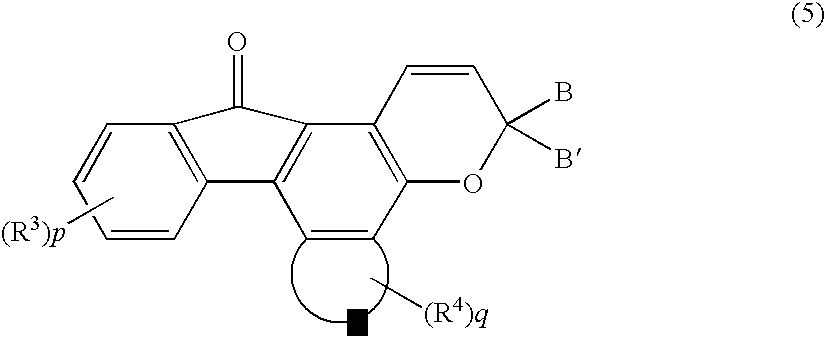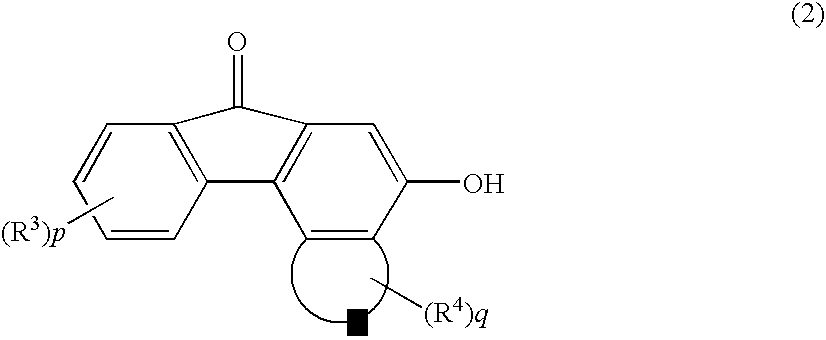Process for preparation of spirofluorenols
a technology of spirofluorene and spirofluorene, which is applied in the field of producing spirofluorene, can solve the problems of requiring excessive amounts of grignard reagent to complete the former reaction
- Summary
- Abstract
- Description
- Claims
- Application Information
AI Technical Summary
Benefits of technology
Problems solved by technology
Method used
Image
Examples
example 1
[0061] 2 Grams (6.5 mmols) of a 3,9-dimethoxy-5-hydroxybenzo[c]fluorene-7-one was suspended in 10 ml of a tetrahydrofuran (THF) followed by the addition of a methanol solution (40 ml) containing 0.31 g (7.8 mmols) of sodium hydroxide, and the mixture was stirred at room temperature for one hour. After 80 ml of toluene was added, the solvent was all distilled off under a reduced pressure to obtain a sodium salt. The sodium salt was dissolved in 50 ml of the THF, and a THF (20 ml) solution containing 1.2 g (7.8 mmols) of a t-butyldimethylsilyl chloride was added dropwise thereto to conduct the reaction at room temperature for 2 hours. The conversion was 99%.
[0062] Then, the THF was distilled off under a reduced pressure, and 2.4 g of a 3,9-dimethoxy-5-t-butyldimethylsilyloxybenzo [c] fluorene-7-one (purity, 97%; yield, 87%)(abbreviated as DBBF) was crystallized from 30 ml of methanol.
[0063] 2.1 Grams (8.3 mmols) of a 1-bromophenanthrene was dissolved in 43 ml of heptane, 5.3 ml (1.6...
example 2
[0073] 10 Grams (36.2 mmols) of a 3-methoxy-5-hydroxybenzo[c]fluorene-7-one was suspended in 150 ml of the THF followed by the addition of 4.4 g (43.5 mmols) of a triethylamine. Then, a solution obtained by dissolving 6.55 g (43.5 mmols) of a t-butyldimethylsilyl chloride in 50 ml of the THF was added thereto dropwise at room temperature, and the mixture was stirred at 45° C. for 6 hours. The conversion was 98%. The THF was distilled off under a reduced pressure and crystallize 12 g of a 3-methoxy-5-t-butyldimethylsilyloxybenzo[c]fluorene-7-one (abbreviated as MBBF)(purity, 98%; yield, 85%) from 230 ml of methanol.
[0074] 10.9 Grams (38.9 mmols) of a 2-biphenyl iodide was dissolved in 150 ml of heptane and was cooled down to −5° C. 26.5 ml (1.6 mols / l, 42.4 mmols) of butyl lithium was added thereto, and the mixture was stirred at −5° C. for one hour. 10.5 Grams (27 mmols) of MBBF prepared above was added thereto, and the THF was added thereto at a temperature of not higher than 0° C...
example 3
[0077] A 3′-methoxy-5′-t-butyldimethylsilyloxyspiro [fluorene-9,7′-benzo[c]fluorene](abbreviated as MBSFBF) was obtained in compliance with Example 2.
[0078] 0.53 Grams (1 mmol) of the above MBSFBF was dissolved in 30 ml of chloroform, cooled down to 5° C., and to which was added 3.4 g (24 mmols) of a diethyl ether complex of boron trifluoride to conduct the reaction at 50° C. for 20 hours. The conversion was 99%. Thereafter, the reaction product was cooled and washed with 24 ml of 1N sodium hydroxide aqueous solution and four times each with 50 ml of water.
[0079] The chloroform was distilled off to obtain 0.40 g of a 3′-methoxy-5′-hydroxyspiro[fluorene-9,7′-benzo[c]fluorene](purity, 96%; yield 97%). The total yield was calculated to be 74%.
PUM
| Property | Measurement | Unit |
|---|---|---|
| Fraction | aaaaa | aaaaa |
| Fraction | aaaaa | aaaaa |
| Fraction | aaaaa | aaaaa |
Abstract
Description
Claims
Application Information
 Login to View More
Login to View More - R&D
- Intellectual Property
- Life Sciences
- Materials
- Tech Scout
- Unparalleled Data Quality
- Higher Quality Content
- 60% Fewer Hallucinations
Browse by: Latest US Patents, China's latest patents, Technical Efficacy Thesaurus, Application Domain, Technology Topic, Popular Technical Reports.
© 2025 PatSnap. All rights reserved.Legal|Privacy policy|Modern Slavery Act Transparency Statement|Sitemap|About US| Contact US: help@patsnap.com



